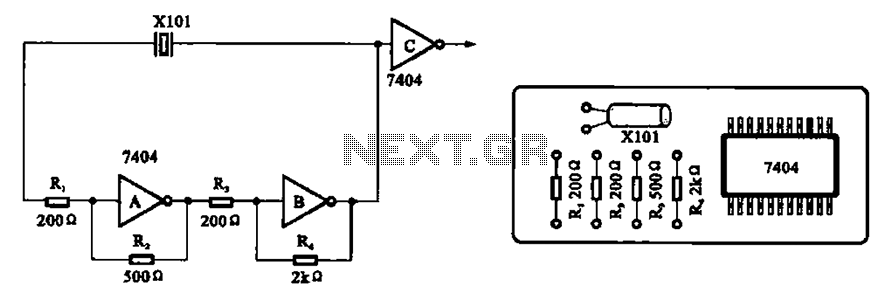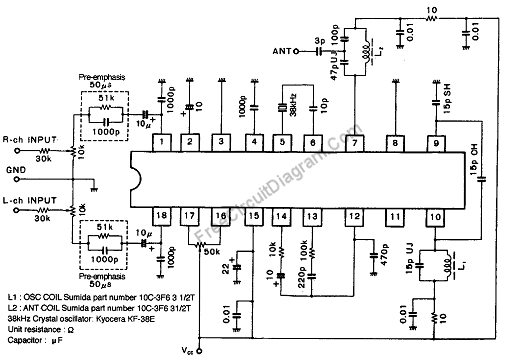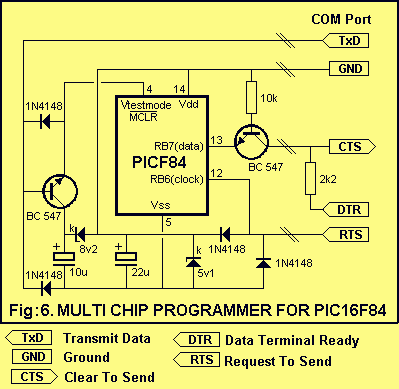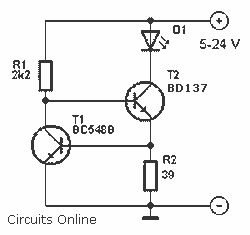
External circuit configuration CPU clock circuit

A clock oscillator is commonly utilized in digital signal processing circuits and microprocessor circuits. Digital signal transmission and signal processors necessitate a clock, which serves as the system's timing signal, while the data signal functions as a synchronization signal. The most prevalent type of clock oscillator is the crystal oscillator, which supplies the clock signal necessary for digital products within the circuit configuration. It typically consists of three quartz crystals (XL01) and an inverting amplifier unit (such as the 74HC04).
The clock oscillator plays a critical role in ensuring the reliable operation of digital circuits by providing a stable and precise timing reference. In digital signal processing, accurate timing is essential for sampling, processing, and transmitting data. The oscillator generates a periodic square wave signal that is used to synchronize various components within a microprocessor or digital signal processing circuit.
The crystal oscillator is favored for its high stability and accuracy, which are achieved through the mechanical properties of quartz crystals. When an electrical signal is applied to the crystal, it vibrates at its natural resonant frequency, generating a consistent output frequency. This output can be further shaped by the inverting amplifier, which enhances the signal integrity and ensures that it meets the required voltage levels for digital logic circuits.
In the configuration involving three quartz crystals (XL01), each crystal may be tuned to different frequencies or used to create a more complex timing signal through frequency division or mixing techniques. The inverting amplifier unit, such as the 74HC04, is crucial for buffering the oscillator output, providing the necessary drive strength to interface with other digital components.
The design and implementation of clock oscillators must consider factors such as power consumption, frequency stability, and temperature variations, which can affect the performance of the oscillator. Therefore, careful selection of components and circuit topology is essential to achieve the desired specifications for a particular application. Clock oscillator is typically used digital signal processing circuit and a microprocessor circuit (digital signal processing circuit is a microprocessor). Digital signal transm ission, signal processors require a clock, which is the system and the beat signal is a time signal, while the data signal identification of a synchronization signal. Common clock oscillator crystal oscillator. It is to provide a clock signal circuit for digital products in the circuit configuration. It is made of three quartz XL01 and the inverting amplifier unit (in the 7074 A, B, c) formed.
The clock oscillator plays a critical role in ensuring the reliable operation of digital circuits by providing a stable and precise timing reference. In digital signal processing, accurate timing is essential for sampling, processing, and transmitting data. The oscillator generates a periodic square wave signal that is used to synchronize various components within a microprocessor or digital signal processing circuit.
The crystal oscillator is favored for its high stability and accuracy, which are achieved through the mechanical properties of quartz crystals. When an electrical signal is applied to the crystal, it vibrates at its natural resonant frequency, generating a consistent output frequency. This output can be further shaped by the inverting amplifier, which enhances the signal integrity and ensures that it meets the required voltage levels for digital logic circuits.
In the configuration involving three quartz crystals (XL01), each crystal may be tuned to different frequencies or used to create a more complex timing signal through frequency division or mixing techniques. The inverting amplifier unit, such as the 74HC04, is crucial for buffering the oscillator output, providing the necessary drive strength to interface with other digital components.
The design and implementation of clock oscillators must consider factors such as power consumption, frequency stability, and temperature variations, which can affect the performance of the oscillator. Therefore, careful selection of components and circuit topology is essential to achieve the desired specifications for a particular application. Clock oscillator is typically used digital signal processing circuit and a microprocessor circuit (digital signal processing circuit is a microprocessor). Digital signal transm ission, signal processors require a clock, which is the system and the beat signal is a time signal, while the data signal identification of a synchronization signal. Common clock oscillator crystal oscillator. It is to provide a clock signal circuit for digital products in the circuit configuration. It is made of three quartz XL01 and the inverting amplifier unit (in the 7074 A, B, c) formed.





